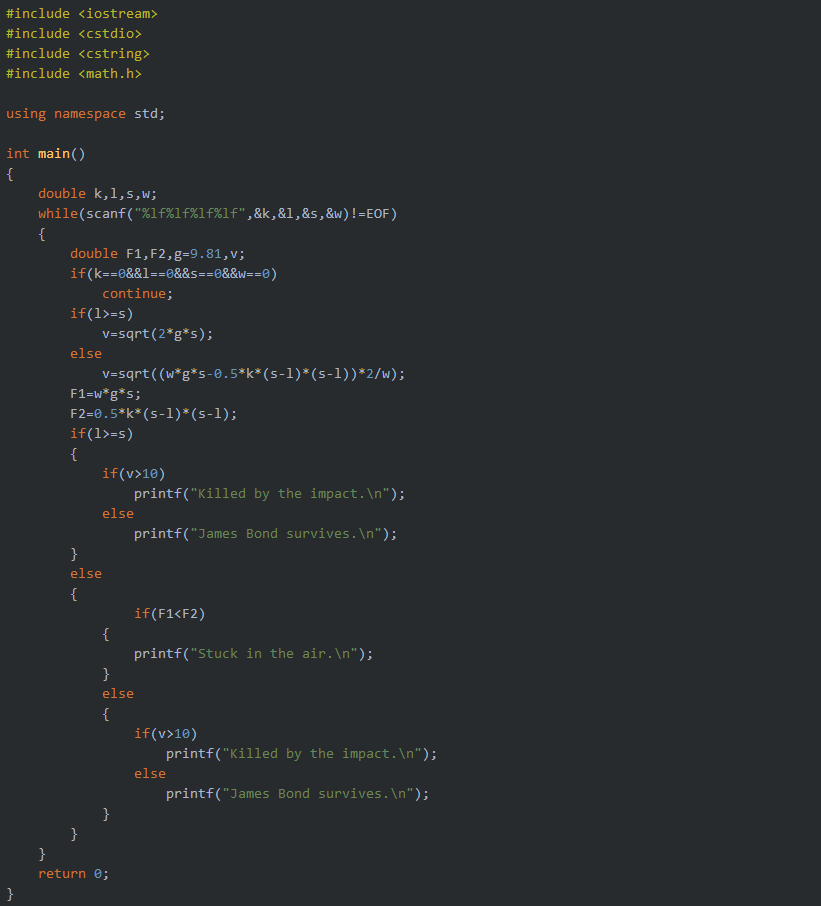Once again, James Bond is fleeing from some evil people who want to see him dead. Fortunately, he has left a bungee rope on a nearby highway bridge which he can use to escape from his enemies. His plan is to attach one end of the rope to the bridge, the other end of the rope to his body and jump off the bridge. At the moment he reaches the ground, he will cut the rope, jump into his car and be gone.
Unfortunately, he had not had enough time to calculate whether the bungee rope has the right length, so it is not clear at all what is going to happen when he jumps off the bridge. There are three possible scenarios:
The rope's length and strength are good. James Bond touches the ground at a comfortable speed and can escape.
As his employer, you would like to know whether James Bond survives or whether you should place a job ad for the soon-to-be vacant position in the local newspaper. Your physicists claim that:
Given the rope's strength k, the nominal length of the rope l in meters, the height of the bridge s in meters, and James Bond's body weight w, you have to determine what is going to happen to our hero. For all your calculations, you may assume that James Bond is a point at the end of the rope and the rope has no mass. You may further assume that k, l, s, and w are non-negative and that s < 200.
Unfortunately, he had not had enough time to calculate whether the bungee rope has the right length, so it is not clear at all what is going to happen when he jumps off the bridge. There are three possible scenarios:
- The rope is too short (or too strong), and James Bond will never reach the ground.
- The rope is too long (or too weak), and James Bond will be going too fast when he touches the ground. Even for a
- special agent, this can be very dangerous. You may assume that if he collides at a speed of more than 10 m/s, he will not survive the impact.
The rope's length and strength are good. James Bond touches the ground at a comfortable speed and can escape.
As his employer, you would like to know whether James Bond survives or whether you should place a job ad for the soon-to-be vacant position in the local newspaper. Your physicists claim that:
- The force with which James is pulled towards the earth is
9.81 * w,
where w is his weight in kilograms and 9.81 is the Earth acceleration in meters over squared seconds. - Mr. Bond falls freely until the rope tautens. Then the force with which the bungee rope pulls him back into the sky depends on the current length of the rope and is
k * Δl,
where Δl is the difference between the rope's current length and its nominal, unexpanded length, and k is a rope-specific constant.
Given the rope's strength k, the nominal length of the rope l in meters, the height of the bridge s in meters, and James Bond's body weight w, you have to determine what is going to happen to our hero. For all your calculations, you may assume that James Bond is a point at the end of the rope and the rope has no mass. You may further assume that k, l, s, and w are non-negative and that s < 200.
Input
The input contains several test cases, one test case per line. Each test case consists of four floating-point numbers (k, l, s, and w) that describe the situation.
Output
Depending on what is going to happen, your program must print "Stuck in the air.", "Killed by the impact.", or "James Bond survives.". Input is terminated by a line containing four 0s, this line should not be processed.
Sample Input
350 20 30 75
375 20 30 75
400 20 30 75
425 20 30 75
450 20 30 75
400 20 30 50
400 20 30 80
400 20 30 85
0 0 0 0
Sample Output
Killed by the impact. James Bond survives. James Bond survives. James Bond survives. Stuck in the air. Stuck in the air. James Bond survives. Killed by the impact.
一个人逃跑要从天桥上跳下去。他有一根绳子。已知绳子长度,劲度系数,天桥高度,人的重量,重力加速度,问你这个人跳下去会是什么情况。
如果他掉在地上的速度大于10就会摔死,如果绳子太短或者劲度系数太大有可能会吊在半空中,如果绳子长度和劲度系数正合适可以逃生。
思路:这道题是物理题吧!!!!首先判断掉在地上的速度,绳子长度大于高度的话直接就是重力势能转化为动能,小于的话就是重力势能减去绳子的弹性势能等于动能。
然后分情况讨论,绳子长度大于桥的高度时判断速度是否大于10,绳子短的时候判断绳子的弹性势能是否大于重力势能,大于的话会吊在半空中,小于的话在判断速度是否大于10.(有种情况我认为吊在半空中的时候可以判断跳下去是否可以但这题不用考虑 因为直接给了个吊在半空中的状况)
重力势能公式W=G*H.
弹性势能:W=0.5*K*X^2;X代表拉伸距离。
动能w=0.5*m*v^2。
代码:
